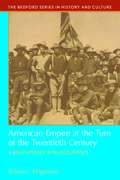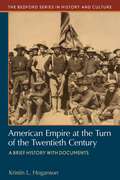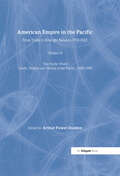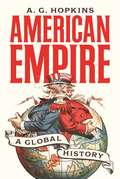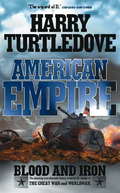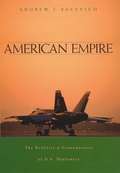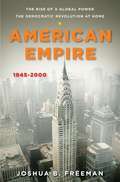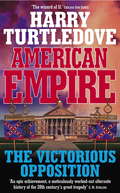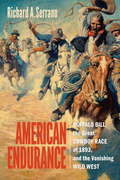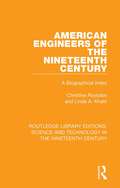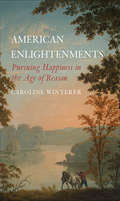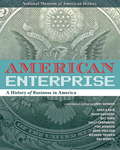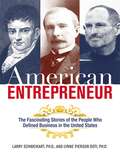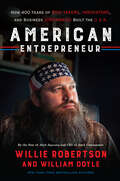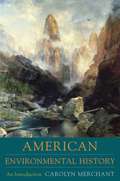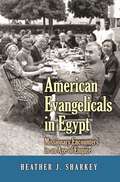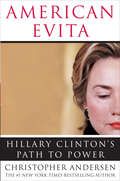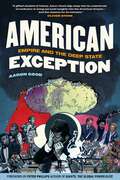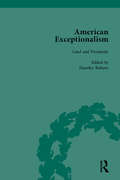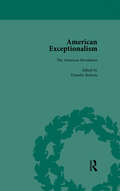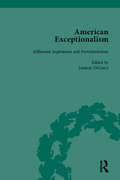- Table View
- List View
American Empire at the Turn at the Twentieth Century: A Brief History with Documents
by Kristin HogansonThis volume introduces students to primary documents on American empire from a pivotal era of U. S. expansion beyond the North American continent in the late-nineteenth and early-twentieth centuries. Along with covering a wide range of places-including Cuba, Puerto Rico, and the Philippines--the documents touch on a wide range of themes, among them race, citizenship, civilization, democracy, cross-cultural encounter, and self-determination. Kristin Hoganson's introduction provides the context essential to understanding this period and the ways in which the echoes of 1898 still reverberate today, including in the reach of U. S. power and the composition of the American people. Through a collection of sources representing the voices of those living under imperial rule as well as those imposing and opposing it, students can consider the American imperial endeavors. Document headnotes, maps, a Chronology of American Empire in the Caribbean and the Pacific, Questions for Consideration, and a Selected Bibliography provide pedagogical support.
American Empire at the Turn of the Twentieth Century: A Brief History with Documents
by Kristin HogansonThis volume introduces students to primary documents on American empire from a pivotal era of U.S. expansion beyond the North American continent in the late-nineteenth and early-twentieth centuries. Along with covering a wide range of places–including Cuba, Puerto Rico, and the Philippines—the documents touch on a wide range of themes, among them race, citizenship, civilization, democracy, cross-cultural encounter, and self-determination. Kristin Hoganson’s introduction provides the context essential to understanding this period and the ways in which the echoes of 1898 still reverberate today, including in the reach of U.S. power and the composition of the American people. Through a collection of sources representing the voices of those living under imperial rule as well as those imposing and opposing it, students can consider the American imperial endeavors. Document headnotes, maps, a Chronology of American Empire in the Caribbean and the Pacific, Questions for Consideration, and a Selected Bibliography provide pedagogical support.
American Empire in the Pacific: From Trade to Strategic Balance, 1700-1922 (The Pacific World: Lands, Peoples and History of the Pacific, 1500-1900 #9)
by Arthur Power DuddenAmerican Empire in the Pacific explores the empire that emerged from the Oregon Treaty of 1846 with Great Britain and the outcome of the Mexican War in 1848. Together, they signalled the mastery of the United States over the continent of North America; the Pacific Ocean and the ancient civilizations of Asia at last lay within reach. England's East India Company in the 17th and 18th centuries had introduced Asian wares including tea to the American colonists, but wars against France and then the struggle for American independence held back expansion by Yankee entrepreneurs until 1783. Thereafter, from the Atlantic seaboard, American ships began regularly to reach China. Merchants, sailors and missionaries, motivated toward trade and redemption like the Europeans they met along the way, encountered the exotic peoples and cultures of the Pacific. Would-be empire builders projected a manifest destiny without limits. Russian Alaska, the native kingdom of Hawai'i, Japan, Korea, Samoa, and Spain's Philippine Islands, as well as a transcontinental railroad and an isthmian canal, acquired strategic significance in American minds, in time to outweigh both commerce and conversion.
American Empire: A Global History (America in the World #25)
by A. G. HopkinsA new history of the United States that turns American exceptionalism on its headAmerican Empire is a panoramic work of scholarship that presents a bold new global perspective on the history of the United States. Drawing on his expertise in economic history and the imperial histories of Britain and Europe, A. G. Hopkins takes readers from the colonial era to today to show how, far from diverging, the United States and Western Europe followed similar trajectories throughout this long period, and how America’s dependency on Britain and Europe extended much later into the nineteenth century than previously understood.In a sweeping narrative spanning three centuries, Hopkins describes how the revolt of the mainland colonies was the product of a crisis that afflicted the imperial states of Europe generally, and how the history of the American republic between 1783 and 1865 was a response not to the termination of British influence but to its continued expansion. He traces how the creation of a U.S. industrial nation-state after the Civil War paralleled developments in Western Europe, fostered similar destabilizing influences, and found an outlet in imperialism through the acquisition of an insular empire in the Caribbean and Pacific. The period of colonial rule that followed reflected the history of the European empires in its ideological justifications, economic relations, and administrative principles. After 1945, a profound shift in the character of globalization brought the age of the great territorial empires to an end.American Empire goes beyond the myth of American exceptionalism to place the United States within the wider context of the global historical forces that shaped the Western empires and the world.
American Empire: Blood and Iron
by Harry TurtledoveThe first volume of the American Empire trilogy from Harry Turtledove, "The Wizard of If".As Turtledove's brilliant series The Great War came to its end, the United States of America, in alliance with Germany, had defeated Great Britain, France and the Confederate States of America in a bloody conflict known as the First World War.Now as the 1920s begin, though, the seeds of a new conflict have already been sown. The United States, led by Theodore Roosevelt, swings wildly towards socialism. In Canada - now a US colony - nationalist terrorists strike against the new American oppressors. But it is in the Confederacy, trapped in a ruinous economic depression, where fascism begins to spread, and the fires are fanned by a charismatic leader who may again plunge the world into war.
American Empire: The Centre Cannot Hold Ebook
by Harry TurtledoveTurtledove's alternate history of America in the last 150 years continues . . . The second book in the American Empire sequence takes the violent American civil war (which has become a world war) to 1924: a time of rebuilding. Life is slowly returning to normal in the devastated cities of Europe and Canada. In the United States, the Socialist Party battles Calvin Coolidge to hold on to power. And it seems as if the Socialists can do no wrong as the stock market soars and America enjoys a prosperity unknown for half a century. But as old names like Custer and Roosevelt fade into history a new generation faces new uncertainties,.In a world of occupiers and the occupied, of simmering hatreds, shattered lives and pent-up violence, the centre can no longer hold. And for a powerful nation, the ultimate shock will come when a fleet of foreign aircraft rains death and destruction on one of the great cities of the United States.
American Empire: The Realities and Consequences of U. S. Diplomacy
by Andrew J. BacevichArguing that since the end of the Cold War, American foreign policy makers have pursued a well-defined grand strategy aimed at preserving and expanding an American Imperium, Bacevich (international relations, Boston U. ) contends that the strategy is continuous with policies pursued during the Cold War. The stated goal of containing communism was only incidental to a larger goal of worldwide commercial integration, a process that is seen as inexorable and beneficent, but paradoxically requires the use of overwhelming military power in response to challenges. The author calls for recognition of the empire, so that it can be better governed. Annotation c. Book News, Inc. , Portland, OR (booknews. com)
American Empire: The Rise of a Global Power, the Democratic Revolution at Home 1945-2000
by Joshua B. FreemanIn this landmark work, acclaimed historian Freeman has created an epic portrait of the movements and developments that propelled America to world dominance both galvanized by change and driven by conflict.
American Empire: The Victorious Opposition Ebook
by Harry TurtledoveTurtledove's alternate history of America in the last 150 years continues . . . The final book in the American Empire sequence takes the violent American civil war (which has become a world war) to the 1930s. Seventy years have passed since the first War Between the States. The North American continent is locked in a battle of politics, economies and moralities. In a world that has already felt the soul-shattering blow of the Great War, North America in 1934 is the powder keg that could ignite another global conflict.The Victorious Opposition is a drama of leaders and followers, spies and traitors, lovers and soldiers. From California to Canada, from combat on the high seas to the secret meetings where former slaves plot a desperate strategy for survival, Harry Turtledove has created a human portrait of a world in upheaval.
American Endurance: Buffalo Bill, the Great Cowboy Race of 1893, and the Vanishing Wild West
by Richard A. SerranoPulitzer Prize-winning journalist and author Richard A. Serrano's new book American Endurance: Buffalo Bill, the Great Cowboy Race of 1893, and the Vanishing Wild West is history, mystery, and Western all rolled into one. In June 1893, nine cowboys raced across a thousand miles of American prairie to the Chicago World's Fair. For two weeks they thundered past angry sheriffs, governors, and Humane Society inspectors intent on halting their race. Waiting for them at the finish line was Buffalo Bill Cody, who had set up his Wild West Show right next to the World's Fair that had refused to allow his exhibition at the fair.The Great Cowboy Race occurred at a pivotal moment in our nation's history: many believed the frontier was settled and the West was no more. The Chicago World's Fair represented the triumph of modernity and the end of the cowboy age. Except no one told the cowboys. Racing toward Buffalo Bill Cody and the gold-plated Colt revolver he promised to the first to reach his arena, nine men went on a Wild West stampede from tiny Chadron, Nebraska, to bustling Chicago. But at the first thud of hooves pounding on Chicago's brick pavement, the race devolved into chaos. Some of the cowboys shipped their horses part of the way by rail, or hired private buggies. One had the unfair advantage of having helped plan the route map in the first place. It took three days, numerous allegations, and a good old Western showdown to sort out who was first to Chicago, and who won the Great Cowboy Race.
American Engineers of the Nineteenth Century: A Biographical Index (Routledge Library Editions: Science and Technology in the Nineteenth Century #8)
by Christine Roysdon Linda A. KhatriFirst published in 1978. This biography aims solve the problem of the lack of access to information regarding American engineers and technologists of the nineteenth-century, whilst also providing opportunities for scholars to study and assess the work of hitherto little known, potentially important figures. This title will be of interest to scholars and students of science and history.
American Enlightenments: Pursuing Happiness in the Age of Reason
by Caroline WintererA provocative reassessment of the concept of an American golden age of European-born reason and intellectual curiosity in the years following the Revolutionary War The accepted myth of the "American Enlightenment" suggests that the rejection of monarchy and establishment of a new republic in the United States in the eighteenth century was the realization of utopian philosophies born in the intellectual salons of Europe and radiating outward to the New World. In this revelatory work, Stanford historian Caroline Winterer argues that a national mythology of a unitary, patriotic era of enlightenment in America was created during the Cold War to act as a shield against the threat of totalitarianism, and that Americans followed many paths toward political, religious, scientific, and artistic enlightenment in the 1700s that were influenced by European models in more complex ways than commonly thought. Winterer's book strips away our modern inventions of the American national past, exploring which of our ideas and ideals are truly rooted in the eighteenth century and which are inventions and mystifications of more recent times.
American Enterprise
by Nancy Davis Andy Serwer David Allison Peter Liebhold Kathleen G. FranzWhat does it mean to be an American? What are American ideas and values? American Enterprise, the companion book to a major exhibition at the Smithsonian's National Museum of American History, aims to answer these questions about the American experience through an exploration of its economic and commercial history. It argues that by looking at the intersection of capitalism and democracy, we can see where we as a nation have come from and where we might be going in the future.Richly illustrated with images of objects from the museum's collections, American Enterprise includes a 1794 dollar coin, Alexander Graham Bell's 1876 telephone, a brass cash register from Marshall Fields, Sam Walton's cap, and many other goods and services that have shaped American culture. Historical and contemporary advertisements are also featured, emphasizing the evolution of the relationship between producers and consumers over time. Interspersed in the historical narrative are essays from today's industry leaders--including Sheila Bair, Adam Davidson, Bill Ford, Sally Greenberg, Fisk Johnson, Hank Paulson, Richard Trumka, and Pat Woertz--that pose provocative questions about the state of contemporary American business and society. American Enterprise is a multi-faceted survey of the nation's business heritage and corresponding social effects that is fundamental to an understanding of the lives of the American people, the history of the United States, and the nation's role in global affairs.
American Entrepreneur: A History of Business in the United States
by Larry Schweikart Lynne DotiThis book vividly illustrates the history of business in the United States from the point of view of the enterprising men and women who made it happen.Ever since the first colonists landed in the New World, Americans have forged ahead in their quest to make good on promises of capitalism and independence. Weaving stirring narrative with economic analysis, this historical deep dive recounts the successes and failures of some of the most iconic business people to grace our history books--from the founding of our country to the present day.In American Entrepreneur, you&’ll learn about how:Eli Whitney changed the shape of the American business landscape;the Civil War impacted the economy, and how it was renewed by the subsequent dominance of Andrew Carnegie and J. P. Morgan;Asa Candler, W. K. Kellogg, Henry Ford, and J.C. Penney led the rise of the consumer marketplace;and Warren Buffett&’s, Michael Milken&’s, and Martha Stewart&’s experience in the &“New Economy&” in the 1990s--and how that economy continues today.It is an adventure to start a business, and the greatest risk takers in that adventure are entrepreneurs. This is the epic story of America&’s entrepreneurs and how they created the economy we enjoy today.
American Entrepreneur: How 400 Years of Risk-Takers, Innovators, and Business Visionaries Built the U.S.A.
by William Doyle Willie RobertsonAmerica is the ultimate start-up venture – and these are the heroes who made it happenThe history of the United States is, to a remarkable degree, the story of its entrepreneurs, those daring movers and shakers who dreamed big and risked everything to build better lives for themselves and their fellow Americans. Drawing on his own family's remarkable journey, Duck Commander CEO and star of the blockbuster Duck Dynasty series Willie Robertson tells the captivating true tale of the visionaries and doers who have embodied the American dream.We begin with the first American entrepreneurs, the Native Americans, who established a highly sophisticated commercial network across the land in the precolonial days. The original Founding Father, George Washington, was also a founding entrepreneur, at the head of a thriving agribusiness venture that gave him the executive skills to steer the nation through the darkest hours of the American Revolution. Then, of course, there were the mega entrepreneurs, legendary figures like Astor, Vanderbilt, Carnegie, and Rockefeller, who transformed America, connected the country with miles of railroad track and supplied the fuel and steel that would help make America the most powerful nation on earth. And in recent years, business visionaries like Jobs, Gates, and Zuckerberg—not to mention the thousands of equally vital, yet smaller-scale, operators who spring up every year—have ushered America into the twenty-first century.American Entrepreneur also relates the story of the Robertson family business, telling how Willie’s family turned a humble regional duck call manufacturer, founded by his father, Phil, into an international powerhouse brand. From a young age, Willie had the entrepreneurial bug, buying candy in bulk and hawking it on the school bus. He did special orders and earned a small fortune for a ten-year-old—until he was hauled into the principal’s office and told to knock it off. So he transferred his focus to Phil’s fledgling business, helping in whatever way he could, from folding endless numbers of cardboard boxes to acting as the company’s customer service department—though he still wasn’t out of grade school. Willie helped build Duck Commander, which he now runs, into a worldwide brand, culminating in the mega success of the Duck Dynasty television show.American Entrepreneur tells a most American tale, of those among us who, through their vision, ingenuity, and good old-fashioned hard work, made something that changed the world.
American Environmental History (Wiley Blackwell Readers in American Social and Cultural History)
by Louis S. WarrenExplore how the peoples of America understood and changed their natural environments, remaking their politics, culture, and societies In this newly revised Second Edition of American Environmental History, celebrated environmental historian and author Louis S. Warren provides readers with insightful examination of how different American peoples created and reacted to environmental change and threats from the era before Columbus to the COVID-19 pandemic. You'll find concise editorial introductions to each chapter and interpretive interventions throughout this meticulous collection of essays and historical documents. This book covers topics as varied as Native American relations with nature, colonial invasions, American slavery, market expansion and species destruction, urbanization, Progressive and New Deal conservation, national parks, the environmental impact of consumer appetites, environmentalism and the backlash against it, environmental justice, and climate change. This new edition includes twice as many primary documents as the First Edition, along with findings from related fields such as Native American history, African American history, geography, and environmental justice. Ideal for students and researchers studying American environmental history and for those seeking historical perspectives on contemporary environmental challenges, this book will earn a place in the libraries of anyone with an interest in American history and the impact of American peoples on the environment and the world around them. Louis S. Warren is the W. Turrentine Jackson Professor of Western U.S. History at the University of California, Davis. He is a two-time winner of the Caughey Western History Association Prize, a Guggenheim Fellow, and recipient of the Albert Beveridge Award of the American Historical Association and the Bancroft Prize in American History.
American Environmental History: An Introduction (Columbia Guides to American History and Cultures)
by Carolyn MerchantBy studying the many ways diverse peoples have changed, shaped, and conserved the natural world over time, environmental historians provide insight into humanity's unique relationship with nature and, more importantly, are better able to understand the origins of our current environmental crisis. <P><P>Beginning with the precolonial land-use practice of Native Americans and concluding with our twenty-first century concerns over our global ecological crisis, American Environmental History addresses contentious issues such as the preservation of the wilderness, the expulsion of native peoples from national parks, and population growth, and considers the formative forces of gender, race, and class. Entries address a range of topics, from the impact of rice cultivation, slavery, and the growth of the automobile suburb to the effects of the Russian sea otter trade, Columbia River salmon fisheries, the environmental justice movement, and globalization. This illustrated reference is an essential companion for students interested in the ongoing transformation of the American landscape and the conflicts over its resources and conservation. It makes rich use of the tools and resources (climatic and geological data, court records, archaeological digs, and the writings of naturalists) that environmental historians rely on to conduct their research. The volume also includes a compendium of significant people, concepts, events, agencies, and legislation, and an extensive bibliography of critical films, books, and Web sites.
American Epic: The First Time America Heard Itself
by Elijah Wald Allison Mcgourty Bernard MacmahonThe companion book to the groundbreaking PBS and BBC documentary series celebrating the pioneers and artists of American roots music—blues, gospel, folk, Cajun, Appalachian, Hawaiian, Native American—without which there would be no jazz, rock, country R&B, or hip hop today.Jack White, T. Bone Burnett, and Robert Redford have teamed up to executive produce American Epic, a historical music project exploring the pivotal recording journeys of the early twentieth century, which for the first time captured the breadth of American music and made it available to the world. It was, in a very real way, the first time America truly heard herself. In the 1920s and 1930s, as radio took over the pop music business, record companies were forced to leave their studios in major cities in search of new styles and markets. Ranging the mountains, prairies, rural villages, and urban ghettos of America, they discovered a wealth of unexpected talent—farmers, laborers, and ethnic minorities playing styles that blended the intertwining strands of Europe, Africa, Asia, and the Americas. These recordings form the bedrock for modern music as we know it, but during the Depression many record companies went out of business and more than ninety percent of the fragile 78 rpm discs were destroyed. Fortunately, thanks to the continuing efforts of cultural detectives and record devotees, the stories of America’s earliest musicians can finally be told. Bernard MacMahon and Allison McGourty, who directed and produced the documentary with American musician Duke Erikson, spent years traveling around the US in search of recollections of those musical pioneers. Their fascinating account, written with the assistance of prize-winning author Elijah Wald, continues the journey of the series and features additional stories, never-before-seen photographs, and unearthed artwork. It also contains contributions from many of the musicians who participated including Taj Mahal, Nas, Willie Nelson, and Steve Martin, plus a behind-the-scenes look at the incredible journey across America. American Epic is an extraordinary testament to our country’s musical roots, the transformation of our culture, and the artists who gave us modern popular music.
American Evangelicals in Egypt: Missionary Encounters in an Age of Empire (Jews, Christians, and Muslims from the Ancient to the Modern World #56)
by Heather J. SharkeyIn 1854, American Presbyterian missionaries arrived in Egypt as part of a larger Anglo-American Protestant movement aiming for worldwide evangelization. Protected by British imperial power, and later by mounting American global influence, their enterprise flourished during the next century. American Evangelicals in Egypt follows the ongoing and often unexpected transformations initiated by missionary activities between the mid-nineteenth century and 1967--when the Six-Day Arab-Israeli War uprooted the Americans in Egypt. Heather Sharkey uses Arabic and English sources to shed light on the many facets of missionary encounters with Egyptians. These occurred through institutions, such as schools and hospitals, and through literacy programs and rural development projects that anticipated later efforts of NGOs. To Egyptian Muslims and Coptic Christians, missionaries presented new models for civic participation and for women's roles in collective worship and community life. At the same time, missionary efforts to convert Muslims and reform Copts stimulated new forms of Egyptian social activism and prompted nationalists to enact laws restricting missionary activities. Faced by Islamic strictures and customs regarding apostasy and conversion, and by expectations regarding the proper structure of Christian-Muslim relations, missionaries in Egypt set off debates about religious liberty that reverberate even today. Ultimately, the missionary experience in Egypt led to reconsiderations of mission policy and evangelism in ways that had long-term repercussions for the culture of American Protestantism.
American Evita: Hillary Clinton's Path to Power
by Christopher Andersen"I don't quit. I keep going."–Hillary Rodham ClintonShe is, quite simply, the most famous, most complex, most loved/hated/admired/reviled woman -- perhaps person -- in America. And, whether she fulfills her life's ambition or not, she can already lay claim to being the first woman ever considered a serious contender for the presidency.From the beginning, there have been the inevitable comparisons to Argentina's legendary Eva Perón. Sex, power, money, lies, scandal, tragedy, and betrayal were the things that defined the lives of both women. Yet most of what we know about Hillary Rodham Clinton is seen in the context of her tumultuous marriage to the 42nd President. Now a power in the Senate, Hillary waits for the right moment to make her own run for the White House. In the style of his #l New York Times bestsellers The Day Diana Died and The Day John Died, as well as Jack and Jackie, Jackie After Jack, George and Laura and Sweet Caroline, Christopher Andersen draws on important sources -- many speaking here for the first time -- to paint a startling portrait of America's most controversial woman. Among the revelations:How U.S. history has been shaped -- and will continue to be shaped -- by the arrangement between Hillary and Bill known as "The Plan."Important new details about the role Hillary played in the scandalous eleventh hour pardons of armed radicals, drug dealers, tax cheats, embezzlers, money launderers and more.How the outgoing First Lady registered like a bride at a gift store and left the White House with $400,000 worth of "gifts" belonging to the American people.How JFK Jr. almost thwarted her Senate plans.New details about Hillary's relationship with Vince Foster.How Hillary has coped with Bill's hundreds of affairs, and the new women in her husband's life.What Martha Stewart did for Hillary, and how Hillary repaid her.How Hillary is using the 2004 elections as a springboard to her own future presidential candidacy—regardless of who wins.Whatever the ultimate judgment of history, the ongoing saga of Hillary Clinton's inexorable rise to power continues to stir passions, and to make her the American Evita.
American Exception: Empire and the Deep State
by Aaron GoodAmerican Exception seeks to explain the breakdown of US democracy. In particular, how we can understand the uncanny continuity of American foreign policy, the breakdown of the rule of law, and the extreme concentration of wealth and power into an overworld of the corporate rich. To trace the evolution of the American state, the author takes a deep politics approach, shedding light on those political practices that are typically repressed in &“mainstream&” discourse. In its long history before World War II, the US had a deep political system—a system of governance in which decision-making and enforcement were carried out within—and outside of—public institutions. It was a system that always included some degree of secretive collusion and law-breaking. After World War II, US elites decided to pursue global dominance over the international capitalist system. Setting aside the liberal rhetoric, this project was pursued in a manner that was by and large imperialistic rather than progressive. To administer this covert empire, US elites created a massive national security state characterized by unprecedented levels of secrecy and lawlessness. The &“Global Communist Conspiracy&” provided a pretext for exceptionism—an endless &“exception&” to the rule of law. What gradually emerged after World War II was a tripartite state system of governance. The open democratic state and the authoritarian security state were both increasingly dominated by an American deep state. The term deep state was badly misappropriated during the Trump era. In the simplest sense, it herein refers to all those institutions that collectively exercise undemocratic power over state and society. To trace how we arrived at this point, American Exception explores various deep state institutions and history-making interventions. Key institutions involve the relationships between the overworld of the corporate rich, the underworld of organized crime, and the national security actors that mediate between them. History-making interventions include the toppling of foreign governments, the launching of aggressive wars, and the political assassinations of the 1960s. The book concludes by assessing the prospects for a revival of US democracy.
American Exceptionalism Vol 1
by Timothy RobertsAmerican exceptionalism � the idea that America is fundamentally distinct from other nations � is a philosophy that has dominated economics, politics, religion and culture for two centuries. This collection of primary source material seeks to understand how this belief began, how it developed and why it remains popular.
American Exceptionalism Vol 2
by Timothy RobertsAmerican exceptionalism � the idea that America is fundamentally distinct from other nations � is a philosophy that has dominated economics, politics, religion and culture for two centuries. This collection of primary source material seeks to understand how this belief began, how it developed and why it remains popular.
American Exceptionalism Vol 3
by Timothy RobertsAmerican exceptionalism � the idea that America is fundamentally distinct from other nations � is a philosophy that has dominated economics, politics, religion and culture for two centuries. This collection of primary source material seeks to understand how this belief began, how it developed and why it remains popular.
American Exceptionalism Vol 4
by Timothy RobertsAmerican exceptionalism � the idea that America is fundamentally distinct from other nations � is a philosophy that has dominated economics, politics, religion and culture for two centuries. This collection of primary source material seeks to understand how this belief began, how it developed and why it remains popular.
